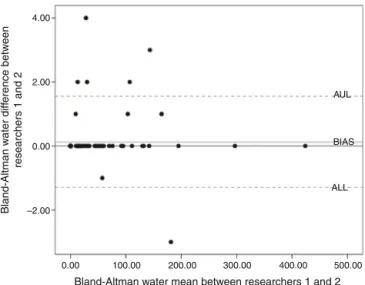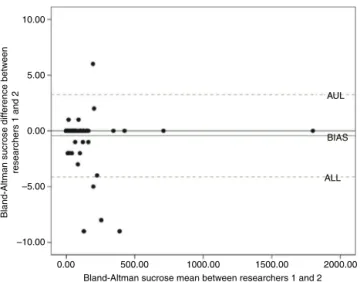www.jped.com.br
ORIGINAL
ARTICLE
A
method
for
the
assessment
of
facial
hedonic
reactions
in
newborns
夽
Caroline
Ayres
a,b,∗,
Charles
F.
Ferreira
a,b,c,
Juliana
R.
Bernardi
a,b,d,
Thiago
B.
Marcelino
a,b,
Vânia
N.
Hirakata
e,
Clécio
H.
da
Silva
a,b,
Marcelo
Z.
Goldani
a,baUniversidadeFederaldoRioGrandedoSul(UFRGS),FaculdadedeMedicina,NúcleodeEstudosemSaúdedaCrianc¸aedo
Adolescente(NESCA),PortoAlegre,RS,Brazil
bUniversidadeFederaldoRioGrandedoSul(UFRGS),FaculdadedeMedicina,Pós-Graduac¸ãoemSaúdedaCrianc¸aedo Adolescente,PortoAlegre,RS,Brazil
cUniversidadeFederaldoRioGrandedoSul(UFRGS),FaculdadedeMedicina,Pós-Graduac¸ãoemCiênciasdaSaúde:Ginecologiae Obstetrícia(PPGGO),PortoAlegre,RS,Brazil
dUniversidadeFederaldoRioGrandedoSul(UFRGS),FaculdadedeMedicina,DepartamentodeNutric¸ão,PortoAlegre,RS,Brazil eUniversidadeFederaldoRioGrandedoSul(UFRGS),FaculdadedeMedicina,GrupodePesquisaePós-Graduac¸ão(GPPG),Porto
Alegre,RS,Brazil
Received25November2015;accepted20June2016
Availableonline23November2016
KEYWORDS Newborn; Facialexpression; Sucrose
Abstract
Objective: Thisstudydescribesaquantitativeandqualitativemethodologytoassesshedonic responsestosweetstimulusinhealthynewborns.
Methods: Adescriptive,cross-sectional,observationalstudy,withhealthynewborns(upto24h oflife),between37and42gestationalweeks,vaginallybornandbreastfedpreviouslytoall tests.Theevaluationofthenewbornsreactions wasperformedby hedonicfacialexpression analysis,characterizedbyfacialexpressionswithrhythmicserialtongueprotrusionafterneutral orsweetsolutionintake.Initially,1mLofwatersolutionwasprovidedtothenewborn,followed bya1-minuterecording.Afterwards,thesameamountof25%sucrosesolutionwasprovided, performing asecondrecording.The concordancebetweenresearchers wasanalyzed bythe Bland---Altmanstatisticalmethod.
Results: Atotalof100newborns(n=49males,n=51females;meanlifetime=15h12min±6h 29min)wererecordedforneutralandsucrosesolutionintake,totaling197videos(n=3missing inthewatertreatment).Thesevideosweredouble-blindanalyzedandthetestrevealeda90% concordancebetweenthetwotrainedresearchers,inrelationtobothsolutions.Theintraclass correlationcoefficientwas0.99forbothsolutions,withasignificantincreaseinfrequencyof hedonicexpressionsevokedbysucrosesolutionintake.
夽 Pleasecitethisarticleas:AyresC,FerreiraCF,BernardiJR,MarcelinoTB,HirakataVN,SilvaCH,etal.Amethodfortheassessmentof
facialhedonicreactionsinnewborns.JPediatr(RioJ).2017;93:253---9. ∗Correspondingauthor.
E-mail:nutricarolayres@hotmail.com(C.Ayres).
http://dx.doi.org/10.1016/j.jped.2016.06.011
0021-7557/©2016SociedadeBrasileiradePediatria.PublishedbyElsevierEditoraLtda.ThisisanopenaccessarticleundertheCCBY-NC-ND
Conclusions: Theseresultsconfirmthattheproposedmethodhasanefficientpowertodetect significant differences between neutral and sucrose stimuli. In conclusion, this evaluation methodofhedonicfacialreactionsinnewbornsreflectstheresponsetoaspecifictaste. ©2016SociedadeBrasileiradePediatria.PublishedbyElsevierEditoraLtda.Thisisanopen accessarticleundertheCCBY-NC-NDlicense(http://creativecommons.org/licenses/by-nc-nd/ 4.0/).
PALAVRAS-CHAVE Recém-nascido; Expressãofacial; Sacarose
Métodoparaaavaliac¸ãodereac¸õesfaciaishedônicasemrecém-nascidos
Resumo
Objetivo: Descreverquantitativamenteequalitativamenteumametodologia para avaliaras respostasfaciaishedônicas,emrecém-nascidossaudáveis,aoestímulodoce.
Métodos: Trata-sedeumestudodescritivo,transversaleobservacional,comrecém-nascidos saudáveis(com até24 horasdevida),entre37-42semanasgestacionais,nascidosporparto vaginalealimentadospreviamenteaostestes.Aavaliac¸ãodasreac¸õeshedônicasdos recém-nascidosfoiconsideradapelasexpressõesfaciaiscomsériesrítmicasdeprotrusõesdelíngua apósaingestãode soluc¸ãoneutra oudoce.Inicialmente,1mLdesoluc¸ãoneutra (água)foi fornecida para o recém-nascido, seguidode uma filmagem de 1minuto. Sequencialmente, amesma quantidadede soluc¸ão de sacarose25%foi fornecida,realizando-se uma segunda gravac¸ão.Aconcordânciaentreospesquisadoresfoianalisadapelométodoestatísticode Bland-Altman.
Resultados: Umtotalde100recém-nascidos(n=49dosexomasculino,n=51dosexofeminino, tempodevidamédia=15h12min±6h29min)foramregistradosparaaingestãodesoluc¸ão neutraedesacarose,totalizando197vídeos(n=3perdasparaotratamentoágua).Estesvídeos foramanalisadosemduplo-cegoeotesterevelouumaconcordânciade90%,paraambasas soluc¸ões,entreospesquisadorestreinados.Ocoeficientedecorrelac¸ãointraclassefoide0,99 paraasduassubstâncias,comumaumentosignificativonasfrequênciasdasexpressõesfaciais hedônicasevocadaspelaingestãodesacarose.
Conclusões: Estesresultados confirmamqueométodopropostopossuipoderestatístico efi-cienteparadetectardiferenc¸asentreestímulosneutrosesacarose.Emconclusão,estemétodo deavaliac¸ãodereac¸õesfaciaishedônicasemrecém-nascidosrefletearespostaparaumgosto específico.
©2016SociedadeBrasileiradePediatria.PublicadoporElsevierEditoraLtda.Este ´eumartigo OpenAccesssobumalicenc¸aCCBY-NC-ND(http://creativecommons.org/licenses/by-nc-nd/4. 0/).
Introduction
Evidencesuggeststhataffectivereactionsreflectthe qual-ityof pleasantorunpleasantevents, sincenewborns have essentiallytwopatternsoffacialexpressionstotaste: pos-itiveemotionalreaction ---hedonic,or negativeemotional reaction---disgust.The sweettasteof sugarusuallydraws positive affective patterns, such as a ‘‘nozzle’’ lip-shape and a rhythmic series of tongue protrusion movements. Thesemovementsareaccompaniedby relaxationoffacial muscles.1Somestudieshavereportedthattheexperience ofatasteduringintrauterinelifecouldimprovethe accep-tance of foods with the same taste in childhood.2---5 The automaticresponsestostimuluscan beinnate,suchasin sweet taste,6 and may change during the course of life, dependingonthetypeof inutero exposure,amongother factorsbeforeandafterbirth.2,7 Thechild’sfacial expres-sionresultingfromasweettasteisanexampleofapositive affectivereactionbehavior.1,8 Inaddition,hedonic expres-sions reflect the activity of specific mesolimbic systems,9 whicharealsoactivatedaftervisualizationoftastyfoods.10 Asvariationsinthiscircuit’sresponsivenessmaypredictthe
riskforweightgain,11behavioralalterationscouldalso indi-cateariskforovereatingand/oroverweightinthefuture.
gustatory-vagalhypothesis regardingneonatalresponsivity to gustatory stimulation.16 In this sense, taste reactivity research demonstrated that sucrose evoked hedonic pat-terns (e.g., lip smacking and rhythmic series of tongue protrusion, accompanied by relaxation of the facial mus-clesandanoccasionalsmile).1,17,18Recently,in2015,Zacche Saet al. analyzed facialresponses to basic tastes among newbornsofwomenwithandwithoutgestationaldiabetes mellitus.19Someofthesestudiesrecordedfacialexpressions throughfilmingtechniques,allowingapreciseevaluationof the frequency of hedonic and aversive reactions, aswell asitsduration.Ofall theaforementioned research,some oftheseinvestigations1,8,12,14---16,19 canbecomparedtothe present manuscript. However,this studymethodologically resemblesonlythatofGanchrowetal.in1983,withalarger samplesize.14Itisnoteworthythatinallthesecomparative studies,therewasnoreportofstatisticalanalysisbetween thetworesearchers.Inthis sense,thisresearchaimedto describeaquantitativeandqualitativemethodologyableto assessthe hedonicresponses tosweet stimulusin healthy newbornsanalyzedbydouble-blinded,trainedresearchers, usingtheBland---Altmanstatisticalmethod.
Methods
Thiswasacross-sectional,observationalstudy,presentinga descriptivemanuscriptfocusingonanadaptedmethodfrom studies by Berridge,Steiner,and Ganchrow1,14,17 toassess thefacialreactions tosweettaste in newborns.Datawas collectedfrom November2010 toMay 2012, ina hospital (GrupoHospitalarConceic¸ão---GHC)locatedinPortoAlegre, RioGrandedoSul,Brazil,which assiststheUnifiedHealth System.
Theconveniencesampleincludedonlyhealthynewborns, up to 24h of life, at 37---42 gestational weeks, vaginally deliveredandbreastfedbeforealltreatments.Childrenof mothers whodid not sign the informedconsent, casesof maternaldiseases (e.g.,diabetes, hypertension,HIV), and newbornswhowerenotexclusivelybreastfedwereexcluded from sample. Maternal and newborn data were collected from medicalrecords and from the prenatal child health handbook.
All proceduresperformed inthis study involvedhuman participants and were in accordance to the ethical stan-dardsofGHCresearchEthicsCommitteeandtotheHelsinki Declarationof1964anditslateramendments.
Hedonicreactionsorpositiveemotionalfacial reactions
Thenewborns’positiveaffectivefacialreactionassessments wereperformedbyhedonicfacialexpressionanalysis, char-acterizedbyserialandrhythmictongueprotrusionthrough freshorneutralsolutionintake.1,8,12
Initially,1mLofneutralsolution(deionizedwater)was provided to the newborn, followed by a 1min recording. Afterthis firstrecording, a second filmingwasperformed after 1mL of water+25% sucrose solution was adminis-trated. It is emphasized that the neutral solution was first provided to all newborns, and that sucrose recor-dingswereperformedonlyafterwatertesting.Allsolutions
wereadministratedorally,pressingthenewborns’masseter musclelightly,openingtheirmouthsandallowing adminis-tration.The facialexpressionswererecordedcontinuously through1min,witha20-cmdistancebetweenthecamera and the newborn, under natural light inside the hospital room.
A Cyber-Shot DSC-S500 camera (Sony®, Tokyo, Japan), with6.0megapixelsand30framespersecond,wasusedfor recordingalltests.Newbornswereplacedinacomfortable position,withoutcrying,neartheirmothers.Beforewater recordings,theywerepreviouslybreastfed.Afterthetests, motherswereorientedtowardthepracticeofnewbornoral care, aswell as encouragedto practiceexclusive breast-feedingthroughexplanationsofitsimportanceandbenefits forboththemotherandthebaby.
Solutions
Deionized water was used as a neutral solution and the sucrosesolutionwascomposedof1mLofdeionizedwater containing0.25gofsucrose---modified fromSteineretal. in2001andAyresetal.in2012.1,20
Solutions were produced by a compounding pharmacy. Thedeionizedwaterwassubjectedtothreepurification pro-cesses:sedimentremoval, bacteriaelimination, andtotal eliminationof micronutrients.Allsolutions were individu-allypackagedina bottledropper; labeledwiththename ofthesolution,quantity,andexpirydate;andfinallysealed andindividuallywrapped ina plasticbag.These solutions wereproduced daily anddelivered onthe samemorning, sincedatacollectionwasperformed in theafternoons. In thisinterval,allsolutionswerekeptunderrefrigerationat 2---8◦C,astheirvaliditywasrestrictedto24hafter prepara-tion.Ifnotusedduringthisperiod,solutionswerediscarded. Allrecipientswereopenedinthepresenceof themother, immediately prior to the testing moment. At the testing time,theywerekeptatroomtemperature(between15◦C and25◦C).
Videoanalysis
All1-minutevideoswerefirstlyanalyzedatanormalspeed bytwotrainedresearchers, toverifywhethertherewere hedonicfacialexpressionsduringtheone-minuterecording. Later,allrecordswereevaluatedframe-by-frameusing Win-dowsMediaPlayersoftware(Microsoft®,WA,USA),slowing thespeedtobetterdetecthedonicfacialexpressions.Every secondwascomposedof 30frames,totalling 1800frames per 60seconds. The frequency of facial reactions in 2-s intervals was recorded for 1min of continuous shooting. Facialexpressionsrepresenting hedonic reactions or posi-tiveaffectivereactionswereconsidered.Forexample,for eachhedonicfacialexpressionortongueprotrusion,a fre-quencywasregistered.Fortheanalysisoftheseresults,the sumsofall60-srecordswerecalculated.1,17
Figure1 Newbornfacialexpressionstoneutral(water,A)and(B)sucrosesolutions.(A)Characteristicnewbornfacialexpressionto neutralsolution(water).(B)Characteristicnewbornfacialexpressiontosucrosesolution,exhibitingtongueprotrusions(designated ashedonicreactionwhenperformedinrhythmicseries).Previouslytotheadministrationofbothsolutions(waterandsucrose),all newbornsshowednospontaneousfacialhedonicresponses.Theintakeofbothsolutionsinducedhedonicreactionexpressions,but thesucrosesolutionevokedhigherfrequenciesofhedonicreactionexpressionsinrelationtointakeoftheneutralsolution. Photosrepresentingnewborn’sbaseline(pre-treatment),duringsolutionadministration,first (ifitoccurred)andlastprotrusion aftersolutionadministration(inminutesandseconds).
Samplesizeestimation
Martin Bland and Doug Altman, authors of the statistical testtoassessagreementbetweenevaluators(concordance analysisusingtheBland---Altmanmethod),statethatforan adequateaccuracyitisimportanttoevaluate100 individ-uals,correspondingtoa95%confidenceintervalanda0.34 standarderrorofdeviation.21
Statisticalmethods
Symmetric data were expressed as mean and standard deviation (SD) and asymmetric data were expressed as median and interquartile ranges. To evaluate the agree-ment between the two raters, a concordance between Bland---Altmanmethodwasapplied.Thismethodology evalu-atesthecorrelationbetweentwovariables(XandY)starting fromagraphicalviewbasedonascatterplotofthe differ-enceofthetwovariables(X−Y)andtheiraverage(X+Y/2). Inthischart,itispossibletovisualizethebias(howthe dif-ferencesderivatefrom zero),the error(dispersion ofthe pointsaroundthemean),theoutliers,andpossibletrends.21 Inordertocomplementtheseanalyses,anintraclass coef-ficient(ICC)wasalsoestimated.Tocomparethefrequency ofhedonicfacialexpressions,valuesevokedbywaterand sucrosesolutions wereanalyzed by the Wilcoxontest. All datawereevaluatedusingStatisticalPackageforSocial Sci-ences(SPSS,Inc.version18.0,IL,USA), version18.0.The levelofsignificancewassetat5%forallanalyses.
Results
The newborns’ average life was 15h 12min±6h 29min hoursandminutes.Amongthe100newbornsevaluated,49% weremaleand51%werefemale.Birthweightaveragewas
4.00
2.00
0.00
–2.00
0.00 100.00 200.00
Bland-Altman w
a
ter diff
erence betw
een
researchers 1 and 2
Bland-Altman water mean between researchers 1 and 2
300.00 400.00 500.00
ALL BIAS AUL
Figure2 Bland---Altmandispersionchartrepresenting inter-rateragreementinrelationtoneutral solution(water).AUL, agreementupperlimit;ALL,agreementlowerlimit.
3274.9±439.85g,with39±1weeksofgestationalage.The meanmaternalagewas23±6years.
A total of 100 newborns were recorded for neutral (water)andsucrosesolutionintake,generating197videos (n=3missingdataforthewatertreatment).Fig.1displays fournewbornssequencesforneutral(Fig.1A)andsucrose (Fig.1B)solutions.
The Bland---Altman test indicated agreement between researchers,bothinrelationtothewatersolution(Fig.2) and thesucrosesolution(Fig.3). Through95% agreement limits,itwasobservedthattherewasanagreementinmore than90%ofthedata.
10.00
5.00
0.00
–5.00
–10.00
0.00 500.00 1000.00 1500.00 Bland-Altman sucrose mean between researchers 1 and 2
Bland-Altman sucrose diff
erence betw
een
researchers 1 and 2
2000.00 ALL
BIAS AUL
Figure3 Bland---Altmandispersionchartrepresenting inter-rateragreementinrelationtosucrosesolution.AUL,agreement upperlimit;ALL,agreementlowerlimit.
neutralsolution(water)wasscored0for bothresearchers (researcher 1: median=0.0, 25th percentile=0.0, 75th percentile=48.5; researcher 2: median=0.0, 25th per-centile=0.0, 75th percentile=48.5). On the other hand, hedonicresponsesevokedbysucrosesolutionwerescored 17and16.0forbothresearchers,respectively(researcher1: median=17.0,25thpercentile=0.0,75thpercentile=98.0; researcher 2: median=16.0, 25th percentile=0.0, 75th percentile=96.8). The intraclass correlation coefficient (ICC)forallanalyseswas0.99forboth(p≤0.001).
Comparinghedonicfacialfrequencyvaluesbetween neu-tral and sucrose solutions, an increase in hedonic facial expression evoked by the sucrose solution(p=0.004) was observed. This result confirms that this methodology dis-plays power to detect differences between sucrose and neutralstimuli(Fig.4).
Discussion
To thebestof authors’knowledge, thisis thefirst Brazil-ian protocol showing an assessment method description for newborns’ (up to 24h of life) affective facial reac-tionsthroughsweettastestimulusinvolvingrecordedfacial expressionanalysis.Thisstudyrepresentsnational compar-ativeresearch(bytworesearchersblindedtothesolutions analyzed --- water and sucrose) using a detailed method-ology for the qualification of hedonic facial reactions. Thisstudyprovidesanationalscientificprotocolwith reli-able reproducibility, considering the degree of statistical agreementbetweenthetworesearchers,confirmedbythe Bland---Altmanmethod.Itwasobservedthatthesweet solu-tion evoked hedonic reactions in infants and that facial expression is an important measure to evaluate possible hedonic responses. The statistical inter-rater agreement confirmsthatthismethodisaneffectiveprotocolfor mea-suringthehedonicimpactofsweettasteinnewborns.
Someresearchershaverecordedfacialexpressionsfrom photographs, thus analyzing affective reactions of infants andanimals.8,12Withavailabletechnology,researcherswere able to videotape facial expressions through recordings,
60
50
40
30
20
10
0
Water solution Sucrose solution
F
acial e
xpression frequency
Figure4 Frequencies ofhedonicexpressionsinresponseto neutral(water)orsucrosesolutions.Hedonicfacialfrequencies wereincreasedinresponsetosucrosesolution,comparedtothe neutralsolution(p=0.004).Theboxrepresentsthe interquar-tile (IQ) range.The whiskers arelines thatextend from the upperandloweredge ofthebox.Aline acrossthebox indi-catesthemedian.Outliersarecaseswithvaluesbetween1.5 and3timestheIQ range(◦). Extremesarecaseswith values
morethan3timestheIQrange(*).
which allowed an accurate assessment of facial expres-sionvariables(e.g., frequency,duration),suchashedonic andaversivereactions.Furthermore,thismethodallowsfor reducingthevideospeedandevaluatingparameters frame-by-frame.Itisalsopossibletoidentifythehedonicresponses totastestimuliinrodentsandprimates.Additionally, Men-nellaetal.describedthatfetusesexhibithedonicresponses throughfacialexpressionsfor tastes, evenbeforebirth.22 Someauthors have already studied children’sresponse to sucrose stimulus, suggesting that an early experience to sweetened water intake could maintain a preference for sucrosesolutionslater in life.6 Theseexpressions induced by tastes produce feelings, as this parameter refers only totastequality,notmeasuringitsintensity.Facial expres-sions are affective reactions for a specific taste hedonic impact/response,reflecting thepleasurefeelingof a par-ticular taste. Additionally, it is not possible toassess the substanceofferedonlybyitssensoryquality.Asaltytaste, forexample,couldextractapositivereactioninthesame waythat a sweet taste does. On the other hand, a sour, bitter,orverysaltytastecouldextractsimilarnegative reac-tions.However,atrainedresearchercouldassesswhether a child liked a taste based on facial expression, consid-ering this asa positive (hedonic)or a negative(aversive) reaction.17
theacceptanceofa certaintaste,a betterunderstanding offeeding behavior in childhoodis provided,which could reflecttheeatingbehaviorinadulthood.
Focusingonthestudyoffacialexpressions,studieshave shown that some taste components induces similar facial reactions among all primates, such as ‘‘gapes’’ for bit-ter flavors,or serial and rhythmic tongue protrusions for sweets.1,17,18 Another study aimed to compare the facial responses to tastes among newborns of women with and withoutgestationaldiabetesmellitus.Thetasteswere eval-uatedbyglucose,sodiumchloride,citricacid,andquinine hydrochlorideadministrations;0.2mLofsolution overthe dorsal surface of the tongue. In this study, the newborns hadtheirfaces andfacialresponses recordedwerecoded accordingtotheBabyFACS,inwhichnewbornsofmothers withgestationaldiabetesmellitusseemtopreferthetaste ofsalt.19
Although thepreference forsweet substances existsin newborns,standardexperienceswithsweetfoodsanddrinks duringdevelopmentcouldbemodulated.Besides,few stud-ieshaveinvestigatedthedirectrelationshipbetweeneating sweets and their real effect on the appetite for sweet tastes in newborns.4---7 Studies that investigated the neu-ral basis for sensory pleasure related to food designated somebrain sub-regionsas‘‘hedonic hotspots,’’which are encephalic areas capable of amplifying causally positive affectivereactions tosweet tastes in responsetocertain neurobiological and neurochemical stimuli (e.g., orexin, opioids, palatable foods, and sweet tastes), generating ‘‘liking’’ or ‘‘pleasurable’’ feelings.9,24---26 These hedonic mechanisms are at least partially distinct from mesocor-ticolimbic circuitry, a biological pathway that generates motivationfor eatingandthe‘‘wanting’’ feeling.24,25 The current evidence suggests that ‘‘hedonic hotspots’’ exist inlimbicbrainstructures,beingcapableofincreasingthe hedonicimpactof natural sensoryrewards,likepalatable and sweet tastes. In this sense, these access points are found in nucleus accumbens (particularlyits medial shell area),24,25 ventral pallidum,26 and parabrachial nucleus.24 Besides, some regions could amplify the sweet hedonic impact, expressing increased ‘‘liking/pleasure’’ reactions forthetasteofsucrose.26
AsreportedbyKringelbachandBerridge,eatingbehavior is one of the basic life pleasures, which could be modu-latedbywhatiseaten or enjoyedindifferentways (e.g., likinganddisliking).27Thesepersonaldifferencesarelinked totheindividual learningof likingand dislikinga specific taste,inadditiontoaninnatepreferencepredisposedtothe basictastes.Someextrinsic,intrinsic,andindividualfactors maycontributetotastepreference,astheyareassociated tosubjective experiencesor modulated byhunger/satiety states.28Thissubjectivetasteperceptionisproducedby dif-ferentsignalstothecentralnervoussystemareas.29,30Taken together,thesedatasupportimportantinformation focus-ingontherepresentationoftastepreferenceinthecentral nervoussystem.
Affective reactivity to taste as a tool for measuring hedonicfunctionsbytestcouldbeappliedasausefuland objectivetoolformeasurementofliking/pleasurehedonic reactions in response to palatable food, based on the quantificationofdifferenttaste-inducedorofacialaffective reactions.1
Thisresearchpresentssomelimitations,suchasnot hav-ingaddedinthesamplenewbornswhoweremorethan24h away from mothers in the hospital rooming.Additionally, anotherlimitationconcernsthesubstancesstudied.As men-tioned before,other substances than sucrose (e.g., salty, sour,orbittertastes)couldbeusedinthisassessment. How-ever, thisresearch’sfocuswasonfacialhedonicreactions evokedbysucrose,justifyingitsspecificuse.Thus,despite theselimitations,theauthorscanhighlightsomeimportant featuresof thisresearchprotocol:thisstudy wasnational comparative research (by two researchers blinded to the substances analyzed---water and sucrose) using a detailed methodology for hedonic facial reaction quantification, using an adequate newborn sample size. Only exclusively breastfednewborns wereincludedinthissample;all new-borns were breastfed previously to the treatments. This researchprovidesanationalscientificprotocolwithreliable reproducibilityoffindings,consideringthedegreeof statis-ticalagreementbetweenthetworesearchers,confirmedby theBland---Altmanmethod.
Consideringtheresults, thehedonic facialreactions in newbornsreflectthehedonicimpactforthisspecifictaste, allowing thismethodology tobeappliedin early life, but in already responsive stages. The authors speculate that hedonicresponsesthroughfacialexpressionsarerelatedto thefeelingofpleasureduetotaste,allowingthisdirect rela-tiontobeinterpretedasagreaterfoodconsumptionofthis tastetypelaterinlife.Moreevidenceconcerningthis neu-ralpleasure/rewardcircuitryrelationshipisnecessary,since itiscapableofmodifyingfoodintakeby‘‘liking/pleasure’’ responsestofoodsortastes,withoutconsideringthe nutri-tionalbalanceornutritionalneeds.Asrewardpathwaysare involved, other pleasurable stimuli may replace the spe-cificconsumptionofpalatablefoodsthatactsthroughthese routes.
Funding
Supported by the Conselho Nacional de Desenvolvimento CientíficoeTecnológico(CNPq),Brazil.
Conflicts
of
interest
Theauthorsdeclarenoconflictsofinterest.
References
1.Steiner JE, Glaser D, Hawilo ME, Berridge KC. Comparative expressionofhedonicimpact:affectivereactionstotasteby human infants and other primates. Neurosci Biobehav Rev. 2001;25:53---74.
2.MennellaJA.Flavourprogrammingduringbreast-feeding.Adv ExpMedBiol.2009;639:113---20.
3.MennellaJA, PepinoMY, Reed DR.Geneticand environmen-taldeterminantsofbitterperceptionand sweetpreferences. Pediatrics.2005;115:e216---22.
4.MennellaJA,GriffinCE,Beauchamp GK.Flavorprogramming duringinfancy.Pediatrics.2004;113:840---5.
5.MennellaJA,JagnowCP,BeauchampGK.Prenatalandpostnatal flavorlearningbyhumaninfants.Pediatrics.2001;107:E88. 6.BeauchampGK,MoranM.Dietaryexperienceandsweettaste
7.Beauchamp GK, Mennella JA. Early flavor learning and its impactonlaterfeedingbehavior.JPediatrGastroenterolNutr. 2009;48:S25---30.
8.SteinerJE. Thegustofacial response: observation onnormal and anencephalicnewborn infants. Symp OralSensPercept. 1973:254---78.
9.Peci˜naS,SmithKS,BerridgeKC.Hedonichotspotsinthebrain. Neuroscientist.2006;12:500---11.
10.VolkowND,FowlerJS.Addiction,adiseaseofcompulsionand drive:involvementoftheorbitofrontalcortex.CerebCortex. 2000;10:318---25.
11.Stice E,Yokum S, Bohon C,MartiN, Smolen A. Reward cir-cuitryresponsivity to foodpredicts future increases in body mass: moderating effects of DRD2 and DRD4. Neuroimage. 2010;50:1618---25.
12.Steiner JE. Discussion paper: innate, discriminative human facialexpressionstotasteandsmellstimulation.AnnNYAcad Sci.1974;237:229---33.
13.CrookCK,LipsittLP.Neonatalnutritivesucking:effectsoftaste stimulation upon sucking rhythm and heart rate. Child Dev. 1976;47:518---22.
14.GanchrowJR,SteinerJE,DaherM.Neonatalfacialexpressions inresponsetodifferentqualitiesandintensities ofgustatory stimulationinresponsetodifferentqualitiesandintensitiesof gustatorystimuli.InfantBehavDev.1983;6:473---84.
15.RosensteinD,OsterH.Differentialfacialresponsestofourbasic tastesinnewborns.ChildDev.1988;59:1555---68.
16.PorgesSW,LipsittLP.Neonatalresponsivitytogustatory stim-ulation: the gustatory-vagal hypothesis. Infant Behav Dev. 1993;16:487---94.
17.BerridgeKC.Measuringhedonicimpactinanimalsandinfants: microstructureofaffectivetastereactivitypatterns.Neurosci BiobehavRev.2000;24:173---98.
18.SmithKS,BerridgeKC.Opioidlimbiccircuitforreward: inter-action between hedonichotspots of nucleus accumbens and ventralpallidum.JNeurosci.2007;27:1594---605.
19.ZaccheSaA,SilvaJR,AlvesJG.Facialresponsestobasictastes inthenewbornsofwomenwithgestationaldiabetesmellitus. JMaternFetalNeonatalMed.2015;28:1687---90.
20.AyresC,AgranonikM,PortellaAK,FilionF,JohnstonCC,Silveira PP.Intrauterinegrowthrestrictionandthefetalprogramming ofthehedonicresponsetosweettasteinnewborninfants.Int JPediatr.2012;2012:6573---9.
21.BlandJM,AltmanDG.Agreedstatistics:measurementmethod comparison.Anesthesiology.2012;116:182---5.
22.MennellaJA, Johnson A, BeauchampGK. Garlic ingestion by pregnantwomenalterstheodorofamnioticfluid.ChemSenses. 1995;20:207---9.
23.SchwartzC,IssanchouS,NicklausS.Developmentalchangesin theacceptanceofthefivebasictastesinthefirstyearoflife. BrJNutr.2009;102:1375---85.
24.Castro DC, Berridge KC. Advances in the neurobiological bases for food ‘liking’ versus ‘wanting’. Physiol Behav. 2014;136:22---30.
25.Castro DC, Berridge KC. Opioid hedonic hotspot in nucleus accumbens shell: mu, delta, and kappa maps for enhance-ment of sweetness ‘‘liking’’ and ‘‘wanting’’. J Neurosci. 2014;34:4239---50.
26.HoCY,BerridgeKC.Anorexinhotspotinventralpallidum ampli-fieshedonic‘liking’forsweetness.Neuropsychopharmacology. 2013;38:1655---64.
27.LeonardBE.PleasuresoftheBrainEditedbyMortenL. Kringel-bach, Kent C.Berridge, Oxford UniversityPress, Oxford. pp 343, ISBN: 978-0-533102-8. Hum Psychopharmacol Clin Exp. 2010;25:429.
28.SmallDM,ZatorreRJ,DagherA, EvansAC,Jones-GotmanM. Changesinbrainactivityrelatedtoeatingchocolate:from plea-suretoaversion.Brain.2001;124:1720---33.
29.KringelbachML.Thehumanorbitofrontalcortex:linkingreward tohedonicexperience.NatRevNeurosci.2005;6:691---702. 30.Small DM. Flavor is in the brain. Physiol Behav. 2012;107:

